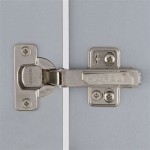Repairing Kitchen Cabinet Lazy Susans: A Step-by-Step Guide
Lazy Susans are a convenient addition to kitchen cabinets, providing easy access to items stored in the back corners. However, over time, these rotating mechanisms can experience wear and tear, leading to issues like squeaking, grinding, or even complete failure. Fortunately, repairing a lazy Susan is often a straightforward process that can be tackled with basic tools and a little know-how. This article will guide you through the steps involved in repairing common lazy Susan problems, empowering you to revitalize your kitchen storage solution.
1. Identify the Issue and Gather Necessary Tools
Before diving into repairs, it's crucial to pinpoint the exact problem. Is the lazy Susan simply squeaking, or is it completely stuck? Determining the root cause will help you choose the appropriate tools and repair methods. Common problems include:
- Squeaking or grinding: This usually indicates worn bearings or a lack of lubrication.
- Sticking or jamming: A buildup of debris or worn gears can cause the lazy Susan to bind.
- Loose or wobbly base: A damaged or worn base can lead to instability and make the lazy Susan difficult to rotate.
Gather the necessary tools based on the identified issue. This may include:
- Screwdriver: To adjust or tighten screws on the base or mechanism.
- Wrench: To loosen or tighten nuts and bolts for accessing the lazy Susan's components.
- Pliers: To grip and manipulate small parts.
- Cleaning cloth: To wipe away dirt and debris.
- Lubricant: Such as WD-40 or a specialized bearing grease.
2. Disassembling and Cleaning the Lazy Susan
Once you've identified the issue and gathered the necessary tools, you'll need to disassemble the lazy Susan to access the problem area. This process may vary depending on the specific design, but generally involves the following steps:
- Remove the Lazy Susan: If it's not already detached, carefully remove the lazy Susan from the cabinet by unscrewing or detaching any brackets holding it in place.
- Disassemble the Lazy Susan: Remove screws and nuts that hold the rotating base and turntable together. Remove any decorative covers or panels that obstruct access to the mechanism.
- Clean the Components: Using a cleaning cloth, wipe away any dirt, dust, or debris accumulated on the bearings, gears, and other moving parts. Thorough cleaning is essential to prevent further damage.
3. Repairing and Reassembling the Lazy Susan
After cleaning, inspect the lazy Susan's components for damage or wear. If necessary, replace any worn or broken parts. This might include:
- Replacing Bearings: If the bearings are worn or damaged, they should be replaced with new ones. These are often available at hardware stores.
- Replacing Gears: If gears are stripped or worn, replacement gears may be needed. Check the manufacturer's website for compatible parts.
- Adjusting Screws and Nuts: Tighten loose screws or nuts on the base or mechanism to ensure a secure fit.
After addressing any damage or wear, lubricate the moving parts to prevent further squeaking or grinding. Use a light oil like WD-40 or a specialized bearing grease. Apply a thin layer to the bearings, gears, and any other moving parts, avoiding excessive application that could attract dust.
Once the repairs are completed, carefully reassemble the lazy Susan in reverse order of disassembly. Ensure all screws and nuts are securely tightened, and test the rotation to guarantee smooth and effortless movement.
Remember that specific repair procedures may vary depending on the type and brand of your lazy Susan. Always consult the manufacturer's instructions or resources for detailed guidance and troubleshooting tips.

3 Ways To Adjust A Lazy Susan Wikihow

Let S Remove The Lazy Susans And Build Shelves My Perpetual Project

Repair Kit For Amerock Turn A Shelf Lazy Susan Bracket Corner

How To Select Correct Hinge Replacements For Lazy Susan Kitchen Cabinet Doors 165 Degree Or 170 Deg

Lazy Susan Cabinet Repair And Improvement Corner Diy

Lazy Susan Fix

How Do I Install A New Lazy Susan In This Cabinet Hometalk

How To Fix An Awkward Corner Cabinet In 5 Easy Steps

Older Style Lazy Susan Parts Needed Doityourself Com Community Forums

Repair Lazy Susan Gave Up
Related Posts








